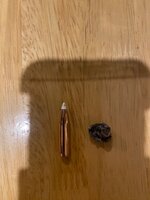I am at a bit of a crossroads with my 6.5 PRC load. Into my second season with my 24" Seekins Precision Havak PH2, I have been shooting the Hornandy 143gr ELD-X factory ammo and have taken two antelope and an elk with it now. At this point, I haven't been real happy with the way that the bullet preformed. On targets they shoot phenomenally through my gun, however on all three animals there has been quite a bit of meat damage without much for visible energy transfer/knockdown power. I'm thinking that I'll try switching loads after this hunting season ends and I'm hoping to use it as an opportunity to cook up a hand load for this gun. My father-in-law has been having some issues with his load as well (Nosler ballistic tip projectile) so it sounds like I'll have someone to go out to the range with to test. His problem has been excessive fragmentation, causing gut punctures on 3 antelope between this year and last year. Anyways...
One of my coworkers was really singing the praise of the Nosler Accubond bullets that he uses in his hand loads and after doing some more research, I think that's the next place I will look. At this point I've been having some trouble finding decent answers on two specific questions:
1) Nosler Accubond vs Accubond LR. What is the performance difference going to be? I know that the LR has a higher BC and is designed to retain energy and velocity out to longer ranges, but how will it do on close shots? Will it's lower minimum expansion velocity make it perform more like a cup and core bullet at close ranges? I keep most of my shots on big game animals within 500 yards. I know I wont really be able to get the full benefits of the LR's design, but I'm mainly interested in the heavier bullet weight offerings - which brings me to my next/main question...
2) How important is bullet weight going to be in a 6.5 PRC? The Accubond LR offers a 150 grain projectile whereas the Accubond just has up to 140 grain (that I have seen). This thinking might be antiquated with a modern cartridge like the PRC, but I'm a little more comfortable with the idea of a 150 grain projectile than a 140 when it comes to taking shots at elk. Can I gain any appreciable amount of punch with a hot 150 grain load over 140 grain? Or am I getting lost in the weeds here?
TIA!
One of my coworkers was really singing the praise of the Nosler Accubond bullets that he uses in his hand loads and after doing some more research, I think that's the next place I will look. At this point I've been having some trouble finding decent answers on two specific questions:
1) Nosler Accubond vs Accubond LR. What is the performance difference going to be? I know that the LR has a higher BC and is designed to retain energy and velocity out to longer ranges, but how will it do on close shots? Will it's lower minimum expansion velocity make it perform more like a cup and core bullet at close ranges? I keep most of my shots on big game animals within 500 yards. I know I wont really be able to get the full benefits of the LR's design, but I'm mainly interested in the heavier bullet weight offerings - which brings me to my next/main question...
2) How important is bullet weight going to be in a 6.5 PRC? The Accubond LR offers a 150 grain projectile whereas the Accubond just has up to 140 grain (that I have seen). This thinking might be antiquated with a modern cartridge like the PRC, but I'm a little more comfortable with the idea of a 150 grain projectile than a 140 when it comes to taking shots at elk. Can I gain any appreciable amount of punch with a hot 150 grain load over 140 grain? Or am I getting lost in the weeds here?
TIA!

